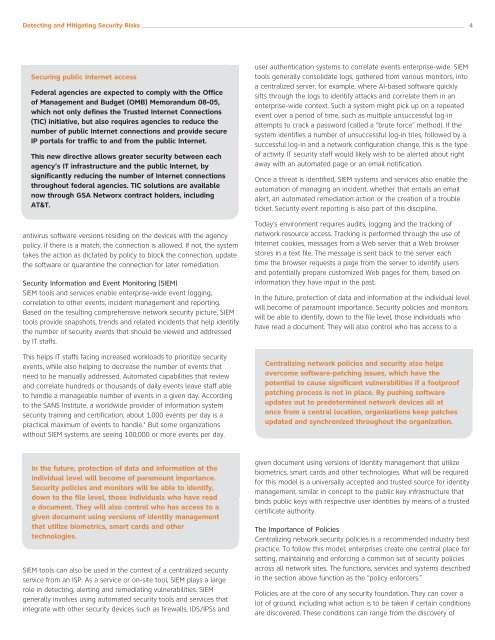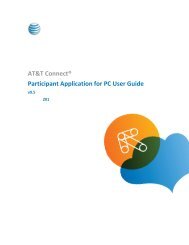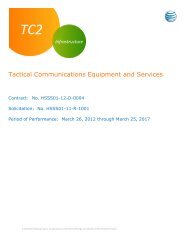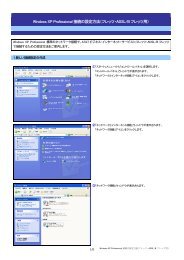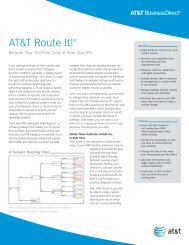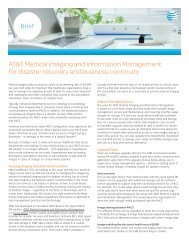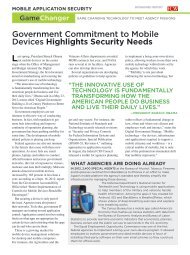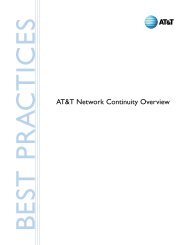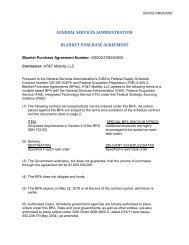Detecting and Mitigating Security Risks - AT&T
Detecting and Mitigating Security Risks - AT&T
Detecting and Mitigating Security Risks - AT&T
Create successful ePaper yourself
Turn your PDF publications into a flip-book with our unique Google optimized e-Paper software.
<strong>Detecting</strong> <strong>and</strong> <strong>Mitigating</strong> <strong>Security</strong> <strong>Risks</strong>________________________________________________________________________________________________________ 4Securing public Internet accessFederal agencies are expected to comply with the Officeof Management <strong>and</strong> Budget (OMB) Memor<strong>and</strong>um 08-05,which not only defines the Trusted Internet Connections(TIC) initiative, but also requires agencies to reduce thenumber of public Internet connections <strong>and</strong> provide secureIP portals for traffic to <strong>and</strong> from the public Internet.This new directive allows greater security between eachagency’s IT infrastructure <strong>and</strong> the public Internet, bysignificantly reducing the number of Internet connectionsthroughout federal agencies. TIC solutions are availablenow through GSA Networx contract holders, includingAT&T.antivirus software versions residing on the devices with the agencypolicy. If there is a match, the connection is allowed. If not, the systemtakes the action as dictated by policy to block the connection, updatethe software or quarantine the connection for later remediation.<strong>Security</strong> Information <strong>and</strong> Event Monitoring (SIEM)SIEM tools <strong>and</strong> services enable enterprise-wide event logging,correlation to other events, incident management <strong>and</strong> reporting.Based on the resulting comprehensive network security picture, SIEMtools provide snapshots, trends <strong>and</strong> related incidents that help identifythe number of security events that should be viewed <strong>and</strong> addressedby IT staffs.This helps IT staffs facing increased workloads to prioritize securityevents, while also helping to decrease the number of events thatneed to be manually addressed. Automated capabilities that review<strong>and</strong> correlate hundreds or thous<strong>and</strong>s of daily events leave staff ableto h<strong>and</strong>le a manageable number of events in a given day. Accordingto the SANS Institute, a worldwide provider of information systemsecurity training <strong>and</strong> certification, about 1,000 events per day is apractical maximum of events to h<strong>and</strong>le.* But some organizationswithout SIEM systems are seeing 100,000 or more events per day.user authentication systems to correlate events enterprise-wide. SIEMtools generally consolidate logs, gathered from various monitors, intoa centralized server, for example, where AI-based software quicklysifts through the logs to identify attacks <strong>and</strong> correlate them in anenterprise-wide context. Such a system might pick up on a repeatedevent over a period of time, such as multiple unsuccessful log-inattempts to crack a password (called a “brute force” method). If thesystem identifies a number of unsuccessful log-in tries, followed by asuccessful log-in <strong>and</strong> a network configuration change, this is the typeof activity IT security staff would likely wish to be alerted about rightaway with an automated page or an email notification.Once a threat is identified, SIEM systems <strong>and</strong> services also enable theautomation of managing an incident, whether that entails an emailalert, an automated remediation action or the creation of a troubleticket. <strong>Security</strong> event reporting is also part of this discipline.Today’s environment requires audits, logging <strong>and</strong> the tracking ofnetwork resource access. Tracking is performed through the use ofInternet cookies, messages from a Web server that a Web browserstores in a text file. The message is sent back to the server eachtime the browser requests a page from the server to identify users<strong>and</strong> potentially prepare customized Web pages for them, based oninformation they have input in the past.In the future, protection of data <strong>and</strong> information at the individual levelwill become of paramount importance. <strong>Security</strong> policies <strong>and</strong> monitorswill be able to identify, down to the file level, those individuals whohave read a document. They will also control who has access to aCentralizing network policies <strong>and</strong> security also helpsovercome software-patching issues, which have thepotential to cause significant vulnerabilities if a foolproofpatching process is not in place. By pushing softwareupdates out to predetermined network devices all atonce from a central location, organizations keep patchesupdated <strong>and</strong> synchronized throughout the organization.In the future, protection of data <strong>and</strong> information at theindividual level will become of paramount importance.<strong>Security</strong> policies <strong>and</strong> monitors will be able to identify,down to the file level, those individuals who have reada document. They will also control who has access to agiven document using versions of identity managementthat utilize biometrics, smart cards <strong>and</strong> othertechnologies.SIEM tools can also be used in the context of a centralized securityservice from an ISP. As a service or on-site tool, SIEM plays a largerole in detecting, alerting <strong>and</strong> remediating vulnerabilities. SIEMgenerally involves using automated security tools <strong>and</strong> services thatintegrate with other security devices such as firewalls, IDS/IPSs <strong>and</strong>given document using versions of identity management that utilizebiometrics, smart cards <strong>and</strong> other technologies. What will be requiredfor this model is a universally accepted <strong>and</strong> trusted source for identitymanagement, similar in concept to the public key infrastructure thatbinds public keys with respective user identities by means of a trustedcertificate authority.The Importance of PoliciesCentralizing network security policies is a recommended industry bestpractice. To follow this model, enterprises create one central place forsetting, maintaining <strong>and</strong> enforcing a common set of security policiesacross all network sites. The functions, services <strong>and</strong> systems describedin the section above function as the “policy enforcers.”Policies are at the core of any security foundation. They can cover alot of ground, including what action is to be taken if certain conditionsare discovered. These conditions can range from the discovery of


